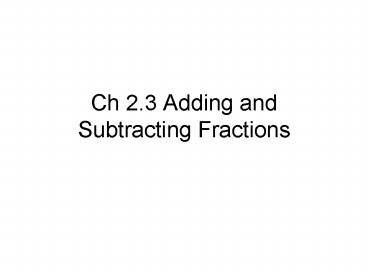Ch 2'3 Adding and Subtracting Fractions - PowerPoint PPT Presentation
1 / 12
Title:
Ch 2'3 Adding and Subtracting Fractions
Description:
Add or subtract the numerators over the common denominator and ... A rod in. long has been cut as shown in the illustration. Assume the waste in each cut is in. ... – PowerPoint PPT presentation
Number of Views:26
Avg rating:3.0/5.0
Title: Ch 2'3 Adding and Subtracting Fractions
1
Ch 2.3 Adding and Subtracting Fractions
2
To add or subtract fractions they must have the
same (common) denominator. Add or subtract the
numerators over the common denominator and reduce
if possible.
3
If the fractions have different denominators,
then a common denominator must be found, all
fractions changed to an equivalent fraction using
that denominator, then do the addition or
subtraction.
4
To find a common denominator, count by multiples
of the largest denominator until a number is
obtained that is divisible by the other
denominator(s).
5
Example
- Count by 12s until a number divisible by 4 is
obtained. - Since 12 is divisible by 4, 12 is the least
common denominator (LCD) - Change each fraction to an equivalent fraction
having 12 as the denominator, add and reduce if
possible.
6
Example
- Count by 16s until a number divisible by 4,6,and
12 is obtained. Since 12 is divisible by 4 and 6,
only check for the 12. - 16,32,48
- Since 48 is divisible by 12, 48 is the least
common denominator (LCD) - Change each fraction to an equivalent fraction
having 48 as the denominator, add and reduce if
possible.
7
To add mixed numbers
- Find the LCD of the fractions
- Add the whole number parts
- Add the fraction parts
- Reduce the result if possible
8
To subtract mixed numbers follow a similar
approach but if the fraction being subtracted is
larger than the one it is being subtracted from,
then you must borrow from the whole number.
9
Add
2 A b/c 3 7 A b/c 12
1_1/4
10
Add
7 A b/c 3 A b/c 4 5 A b/c 11 A b/c 12
11
A blueprint calls for a piece of bar stock
in. long. If a tolerance of in. is
allowed, what is the longest and shortest
acceptable measures for the piece?
12
A rod in. long has been cut as shown in
the illustration. Assume the waste in each cut is
in. What is the length of the remaining
piece?































